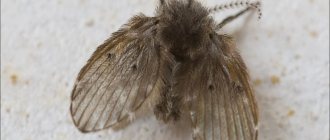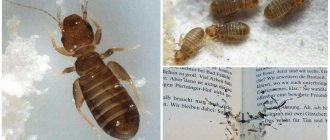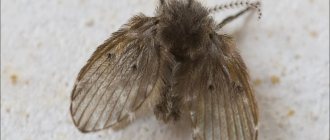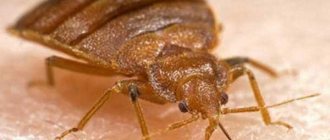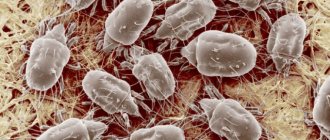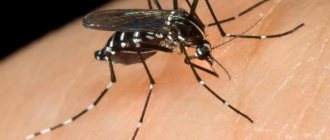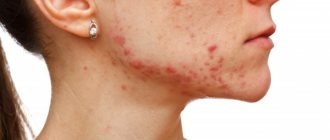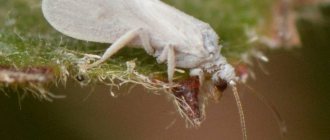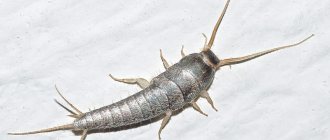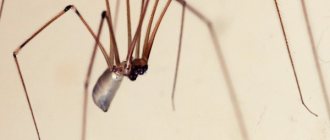A person does not think about being close to microscopic mites until an allergic reaction occurs. These synanthropic organisms have long settled in our homes. Here they found favorable conditions and food in the form of particles of human epidermis. Mites in pillows, blankets, and upholstered furniture are not visible to the naked eye, but for sensitive people their presence results in a bouquet of various diseases from dermatitis to bronchial asthma.
Microscopic inhabitants of pillows
Mites that live in feather pillows are not related to the parasites that live on birds. This is a separate species - Dermatophagoides or house dust mites. Their sizes are 0.1-0.3 mm, so we don’t even notice the presence of millions of arthropod creatures. When viewed through a microscope, an oval, convex body covered with bristles and four pairs of legs are visible. There are suction cups on the limbs with which the tick clings to the surface. At high magnification, you can see powerful chelicerae - claw-like appendages with which dust mites gnaw particles of skin.
Attention. According to scientists, colonies of arachnids make up about 80% of the dust in an apartment.
Dust mites belong to the class of arachnids, the order of acarimorphic mites. The peculiarity of this group is the ability to feed on hair, feathers, skin secretions and particles. 150 species of mites have been found in house dust. Dermatophagoides pferohysimmus and Dermatophagoides pteronyssinys play a major role in the formation of an allergic reaction in humans.
A large number of mites live not just in dust, but in bedding. There are several reasons for this choice:
- During sleep, we heat the pillow and bed to a comfortable temperature of +25-300, which is preferred by arachnids.
- Skin secretions cause increased humidity.
- A large amount of human epidermis remains in the bed, on which ticks feed.
Information. Arthropods that live in dust and bedding do not bite humans or suck their blood. They are not carriers of dangerous diseases like the Ixodid species.
How do ticks get into the house? They can be carried on clothing, when pillow filling is not properly treated, or on pet fur. The lifespan of parasites is 65-80 days. During this time, the female manages to lay 60-200 eggs. Arthropods spend most of their lives feeding on human remains. They defecate up to 20 times per day. Excrement is the main cause of allergic reactions in humans. If you consider that millions of individuals live in bed, then it is clear what kind of load is placed on the immune system.
Attention. Without washing, a feather pillow over a period of 5 years consists of 50% of its weight from dust, skin secretions, mites and their waste products.
More about the parasite
One of the human companions, the linen or bed mite, lives for several hundred years and is distributed in all parts of the world. He feels comfortable with a person. It feeds on dead skin cells, dandruff, lost hair, hides in the folds of dirty bed linen, in pillows, blankets, mattresses and feels great in a dusty room that has not been cleaned for a long time.
A person does not notice the presence of a bed mite if he has good immunity and does not know what an allergic reaction is.
Sensitive people have it more difficult. Their skin and respiratory organs respond to pest bites with endless runny nose, coughing, sneezing, and skin irritations in the form of a small red rash.
It is possible to examine a bed mite (it is a type of saprophyte) only with the help of a microscope, it is so small.
A tick (as we see it in photographs) looks like this:
- yellow-brown;
- the body is flattened, covered with chitin;
- length – from 0.2 to 0.6 mm;
- six limbs with suction cups;
- head in the shape of a triangle.
An adult tick lives for a month and a half, during which time the female lays more than three hundred eggs.
Danger of House Dust Mites
Small particles of Dermatophagoides mites and their feces are strong allergens. The excrement contains the proteins Der f1 and Der p1. They have a particularly detrimental effect on children living in urban areas. In rural areas, where a child comes into contact with animals and various microorganisms, he develops a strong immune system. Urban children are more susceptible to diseases; in 70% of cases of bronchial asthma, the source of the problem was an allergy to dust mites. Particles and secretions of arachnids enter the human body through the respiratory tract. Contact with them causes immune reactions on the skin. In areas of irritation, arthropod protein easily penetrates the skin, aggravating the problem.
Symptoms of an allergy to mites in pillows:
- sneezing and a feeling of nasal congestion without a cold;
- obsessive, incessant cough;
- loss of appetite;
- shortness of breath and difficulty breathing during exercise;
- swelling of the eyelids, itching;
- red rashes on the face.
When performing diagnostics, the presence of an allergen to house dust mites is detected. In addition to an allergic reaction, they cause other serious illnesses:
- conjunctivitis;
- atopic dermatitis;
- bronchial asthma;
- allergic rhinitis.
Information. In many countries, feather and down filled pillows are prohibited for use in hotels, childcare centers and hospitals.
ethnoscience
Many people prefer to turn to alternative medicine methods to treat feather mite bites.
- One of the most effective recipes for parasitic effects is calendula infusion. The product is applied to a cotton pad and treated for skin inflammation.
- You can use aloe juice as a compress: apply to a bandage and apply to the skin.
- In case of severe damage to the skin, mix castor oil with trichopolum and apply a bandage for 8-10 hours daily.
How to get rid of ticks in the house
There are several ways to get rid of ticks in pillows. It is worth considering that the effect of the majority is temporary. Maintaining cleanliness and caring for bedding are the basic rules that help reduce the number of synanthropic parasites.
Impact of temperature
Parasites have always lived in feather pillows, and low temperatures have traditionally been used to combat them. On a cold winter day, it is recommended to take the pillows outside and leave them for several hours. The longer they stay in the cold, the better. More ticks will die during this time.
In summer, bedding is placed in direct sunlight. This is both heating and exposure to ultraviolet radiation. The internal filling dries well, and parasites do not like dryness. Exposure to UV rays neutralizes tick waste products. Another opportunity to influence uninvited residents is treatment with a steam cleaner. The disadvantage of this method is that it only affects adults. Eggs are not sensitive to cold and heat. This means that after some time a new generation of dust mites will grow up.
Information. To treat bedding in hospitals and hotels, special chambers are used, where not only adult ticks are destroyed, but also their eggs.
Habitat
The feather species is a superfamily of mites in the order Acariformes. It has a translucent body, consisting of 2 fused sections, the entire surface of the body is covered with scales, their length varies from 0.3 mm to 0.5 mm.
They can parasitize the feathers of birds, causing them to fall out. Nymphs often burrow under the skin of birds. Parasites can live in feather pillows, upholstered furniture, carpets, and places where there is a lot of dust, and through this they infect humans.
Feather mites in humans can cause diseases such as urticaria, visual and hearing impairment, and asthma. The most favorable place for breeding is down and feather pillows. Due to the combination of human sweat and the material from which the pillow is made, the humidity level inside is kept optimal for the reproduction of parasites.
People usually ventilate their rooms before going to bed, and this is also a favorable condition for ticks, since they love fresh air. These parasites multiply very quickly. If not properly cared for, any down or feather bedding will weigh heavier after 3-5 years due to the parasites, dust, and dirt accumulated in it.
Feather mites in pillows are located as follows: per 1 cm from 150 to 200 mites. Parasites mainly reach humans through feather and down pillows, and when they come into contact with human skin they cause discomfort.
Due to the fact that it is almost impossible and very difficult to completely remove these parasites from bedding, the use of down and feather bedding has been banned in many countries, especially in institutions such as kindergartens, hospitals, hostels, hotels, sanatoriums, etc. .
In this case, when planning the purchase of bedding, you should give preference to synthetic materials (sintepon, holofiber). These materials are less susceptible to the colonization of parasitic neighbors, and their care is much easier
If you want to give preference to natural materials, then you can pay attention to bamboo fibers, coconut, buckwheat, hop cones, meadow hay (you should pay special attention to ensure that poisonous herbs and plants do not get in and cause an allergic reaction)
If possible, pillows should be changed every 0.5-1 year (with constant use).
You can do it in a less expensive way by dry cleaning your down and feather products at intervals of 1 time every 2-3 years. It is necessary to take into account exactly how this procedure will take place, whether feathers will be removed, and what kind of cleaning (chemical, mechanical, water). The quality of cleaning and, accordingly, the number of remaining parasites depends on this. The feather contained in the pillow can be washed independently at home:
- transfer the contents of the pillow into a loose fabric bag, tie it and soak in a soap solution (it is better to use laundry soap);
- leave in this warm soapy solution for 3-4 hours, periodically shake this bag in water and gently knead the contents;
- rinse thoroughly several times;
- hang in the fresh air in a sunny place, periodically sort through and knead the contents.
If this is not possible, then you can use a simple method of tick prevention - take the pillow out onto the balcony 1-2 times a month (from morning to evening, otherwise there will be no positive result), regardless of the time of year. But it will not be possible to get rid of it 100%, since using this method only adult individuals will die, while the larvae will remain.
In order to reduce the risk of infection in the bedroom, you need to regularly do wet cleaning (wipe dust, clean furniture, wash floors). All kinds of bedding (blankets, bedspreads, covers for mattresses and sofas, pajama suits, bathrobes) must be washed and dried in the fresh air as often as possible.
The process of killing ticks in pillows is very troublesome and difficult, but if you regularly monitor this, it will be much easier.
Acaricidal preparations for use in the home
Regular washing of bedding and ironing helps to effectively cope with parasites. But not all fabrics can be washed at high temperatures and ironed. To neutralize allergens and cope with mites at any temperature, a special Acaril liquid is added to the washing machine. The same product, released in powder form, can be used to clean carpets.
Wet cleaning is the main weapon in the fight against dust and its inhabitants. Its effect can be enhanced by adding special All-Rug shampoo to the water. The product is sold as a concentrate and can be used to clean natural and synthetic pile of furniture and carpets. It is used in a washing vacuum cleaner and for manual cleaning. The drug is diluted 1:30 in the first month, then a solution of 1:60 is sufficient. The product removes dirt, allergens and mold well, and has a pleasant aroma.
The Allergoff line of products is an acaricidal additive for washing bed linen and a spray. One sachet of Allergoff rids laundry of mites and their waste products. It also works against fleas and can be used to wash pet bedding.
Allergoff spray is capable of destroying parasites at any stage of development. The aerosol form makes it easy to treat mattresses, blankets, carpets and upholstered furniture. The action of the acaricidal drug causes the death of mites in down pillows 1 hour after spraying. Bedding must be treated from all sides. The product is safe for people; objects can be used 1 hour after its application. The active components of the drug are placed in special capsules, their effectiveness is 6 months. The spray is odorless and does not leave stains after use.
Spray "Akarosan" when sprayed, penetrates into the body of dust mites when feeding and through the chitinous shell. The main active ingredient of the drug is benzyl benzoate. The spray enlarges arthropod excrement, allowing it to be collected with a vacuum cleaner. Particles of the drug remain in the structure of the treated surface for a long time. They have a detrimental effect on subsequent generations of ticks. The protective effect of Akarosan is 6-9 months.
Folk recipe
Table salt will help reduce the number of parasites. It is necessary to prepare a solution from it: 200 g of the product is dissolved in 1 liter of warm water. This composition wipes the areas of greatest accumulation of dust mites - baseboards, window sills, shelves. After moistening a napkin in this solution, wipe upholstered furniture, toys, and mattresses. The main advantages of the solution are affordable cost and effectiveness. The apartment is treated 2-3 times a month.
What to do
If you suspect the presence of bedbugs in your pillow, you must first take measures aimed at identifying the parasites.
The following signs may indicate an intrusion by uninvited guests:
- Traces of the vital activity of parasites, that is, their excrement, remain on bed linen and home textiles. You can see them with the naked eye; in appearance they resemble dark pellets or dots.
- After sleep, so-called “tracks” may appear on the skin, that is, reddish spots located sequentially. They often itch and there is a possibility of tissue swelling.
- Bed linen may become saturated with the unpleasant smell of fermented raspberries.
Caring for feather pillows
You don't have to give up your favorite feather pillows because of mites. They need to be looked after properly. In addition to seasonal drying and freezing, feather washing is recommended. Once every 2 years, pillows are taken to dry cleaning, where appropriate treatment is carried out. You can wash your feathers at home. To do this, you will need a canvas bag the size of a pillow, soap, and ammonia.
The work is performed in the following sequence:
- The feather is poured into a prepared bag, which is tied tightly.
- A special soap solution is prepared in a basin or other container with a volume of 10 liters. You will need 100 g of laundry soap and 100 g of ammonia. After mixing all the ingredients, a bag of feathers is lowered into the container.
- Soaking takes place for 4 hours, periodically the bag is turned over, and the contents are kneaded with your hands.
- Next is rinsing, you will need to change the water several times until all the soap and dirt disappears.
- Fabric with wet feathers is hung in a draft. Washing is done on a sunny day so that everything dries quickly. You will need to wait until it dries completely. In order for the pen to dry evenly, you need to periodically shake it and knead it.
At the same time, the diaper is washed with the addition of an acaricidal drug. Dry fabric is ironed.
Treatment of demodicosis
First of all, the patient needs to go on a strict diet, not eat canned and pickled foods, smoked meat and sausage, fried foods, smoked and dried fish, dishes with a large number of herbs and spices, completely eliminate alcohol, eat chocolate in moderation, drink strong tea and coffee less often, limit yourself to sweets.
It is strictly forbidden to go to the solarium and stay in the open sun for a long time in the summer.
The use of foundation and powder is prohibited; it is advisable to completely eliminate all cosmetics during treatment, and throw away old products, as they also contain mites. Makeup brushes should be thoroughly disinfected to avoid becoming infected with demodicosis again. Do not use day or night cream or nourishing masks. Instead, it is better to use cleansing foams, tonics, and gel serums.
Volvit
The patient should wash with water at room temperature, not hot.
Squeezing pimples is strictly prohibited, as this promotes the spread of infection to other areas of the face.
The patient is prescribed vitamins (“Volvit” or “Vitrum”), which include group B, C and other minerals.
Prevention of demodicosis consists of following the following rules: you need to pay special attention to personal hygiene, change the pillowcase every day or iron it with an iron, do not wipe yourself with a cloth towel after washing, it is better to use disposable dry towels. Use Spregal to spray pillows to kill parasites. It is strictly forbidden to visit the sauna and swimming pool
It is strictly forbidden to visit the sauna and swimming pool.
Sedafiton
Try to expose yourself to stress as little as possible; at first it is recommended to take sedatives, for example, Sedafiton.
Try not to overwork your body and spend no more time in fresh air. If demodicosis of the eyes is detected, then you should reduce the load on them, smear the eyelashes with a specialized gel for demodex of the eyelids. If there are animals in the house, it is necessary to clean the fur.
The most well-known drugs for the treatment of feather mites are benzyl benzoate, ichthyol ointment, tar soap and metronidazole. No less effective are sulfur-based ointments, for example, Wilkinson's sulfur-salicylic ointment. It kills germs, relieves inflammation, and has an antiseptic effect. The course of treatment with ointment lasts from five days. One of the negative aspects is the unpleasant pungent odor.
Vidal's milk is an excellent way to cope with demodicosis, as it effectively kills parasites, reduces sebum production and fights stagnant acne spots.
It is recommended to take Trichopolum or Tetracycline internally. The course will last up to 10-14 days.
Trichopolum
Replacement of down and feather
The times when down pillows were considered the best are in the past. Today there are many fillers in which parasites do not like to settle.
Herbal options include:
- buckwheat husk – elastic, hypoallergenic, with a pleasant aroma;
- bamboo fiber – antibacterial, elastic, breathable;
- latex is elastic, easy to clean, eliminates the appearance of mites and other microorganisms.
Synthetic polyester fillers allow for more frequent hygienic treatment:
- holofiber – non-woven material;
- comfort - elastic polyester balls;
- Sintepon is an inexpensive material, but quickly loses its shape.
When choosing a filler, consider the age and individual needs of the person. For children, it is better to choose natural fibers that do not cause allergies. Ticks that live in pillows do not grow in buckwheat and bamboo.
Conclusion
A feather pillow is an environmentally friendly product, so to speak. It has a number of worthy qualities, thanks to which the product served our ancestors for many years. Now scientists are attributing more and more shortcomings to it, proposing to replace natural feathers with a synthetic analogue. However, the point is omitted that synthetic fillers also have a number of positive and negative characteristics.
By choosing a high-quality feather pillow, the buyer receives a natural product that, with proper care, will last a long time.
Sources
- https://FB.ru/article/411724/perevoy-klesch-lechenie-i-simptomyi-u-cheloveka
- https://StopKlopam.com/kleshhi-v-podushkah/
- https://misterklop.ru/klesshi/kleshhi-v-podushkah-perevye-kleshhi-prichina-bessonnitsy-kto-takie-otkuda-berutsya-opasny-li-dlya-cheloveka-i-kak-ot-nih-izbavitsya- foto-pod-mikroskopom
- https://like2sleep.com/postelnye-prinadlezhnosti/podushki/kleshhi-v-podushkakh-kak-izbavitsya-ot-nep.html
- https://dezvredexpert.com/kleshhi/vidy-kleshhej/kleshhi-v-podushkax/
- https://sichovka.ru/parazity/kleshchi-v-podushkah.html
- https://DobryjSon.ru/spalnoe-mesto/uhod/kleshhi-v-podushkax.html
- https://beetlestop.ru/kleshi-v-podushkah/
- https://polzaivredno.ru/perevye-podushki-chem-vredny-i-chem-polezny/
Preventive actions
To protect your loved ones from allergic reactions and reduce the negative impact of dust mites to a minimum, following simple rules:
- Change pillows and mattresses every 5-6 years. Without proper care, they accumulate a huge amount of mites and mold.
- All bedding, as well as bedspreads, pajamas, and dressing gowns should be washed and shaken out as often as possible. It is recommended to dry these items in the sun.
- Use acaricidal sprays to treat the surface of upholstered furniture, toys, and carpets.
- Regularly carry out wet cleaning of the premises, do not allow dust to accumulate under the bed and in the corners of the room.
- If one of the family members is prone to allergies, it is necessary to remove items from the house that accumulate dust - carpets, drapes.
- Ventilate rooms frequently and maintain humidity at 40%.
- Refuse to store old pillows and mattresses in your apartment and immediately get rid of unnecessary things.
It is impossible to completely destroy dust mites; their population is regularly replenished. But everyone can reduce their numbers and make their home safe.

